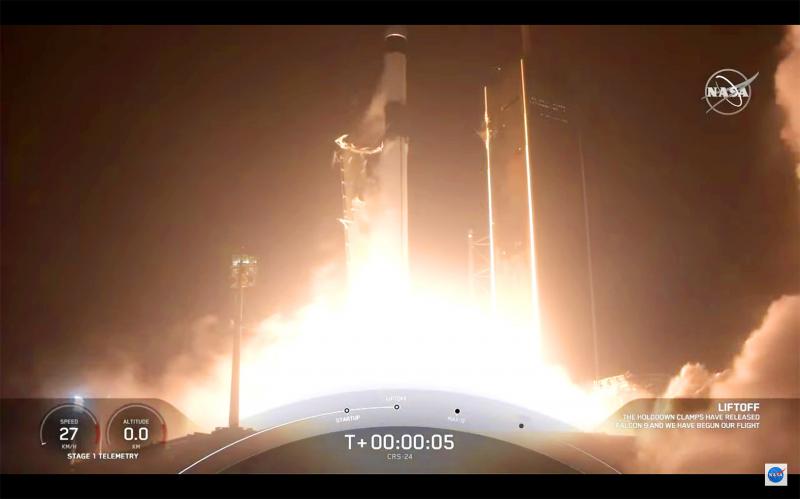A batch of virus-like particles developed by Taiwanese researchers were yesterday launched into space by Space Exploration Technologies Corp (SpaceX), as part of a Commercial Resupply Service (CRS) mission to the International Space Station (ISS).
The CRS-24 mission — using SpaceX’s Dragon spacecraft and a Falcon 9 rocket — launched at about 5:07am from Kennedy Space Center in Florida.
The National Synchrontron Radiation Research Center (NSRRC), which is affiliated to the Ministry of Science and Technology, cultivated the particles.

Photo: screen grab from Youtube
The batch would stay on the space station for one month for crystallization experiments, the center said last month.
The delivery was coordinated by Taiwan’s space service supplier HelioX Cosmos Co (陽翼先進科技) and Japan’s Space BD Inc, which was appointed as the sole private partner by the Japan Aerospace Exploration Agency (JAXA) because of its high-quality protein crystal growth experiment service.
It is the first time that Taiwan has conducted such an experiment, thanks to the commercialization of space technology, HelioX Cosmos founder and chief executive Bill Chang (張懷謙) said yesterday, adding that JAXA had conducted similar experiments for nearly a decade.
It was moving to watch the batch of particles lift off into the space — very different from watching other launch missions, NSRRC deputy director Chen Chun-jung (陳俊榮) said yesterday, adding that he hopes to one day watch a launch mission on site.
The particles would crystallize while in space, and after being returned to Earth, they would be kept in liquid nitrogen at minus-196°C and be sent back to the center in Hsinchu, he said.
“We expect the quality of the particles’ crystallization to elevate significantly in a gravity-free environment, in comparison with that seen in general laboratories on Earth,” Chen said.
With better crystallization, researchers can better analyze the viruses’ atomic structures and improve understanding of their pathogenic mechanisms, he said.
After the particles are returned to the center, researchers plan to use high-intensity X-ray and protein crystallography technology at the center’s Taiwan Photon Source facility to observe changes in the particles, the NSRRC said, adding that it hopes to make breakthroughs in precision medicine and pandemic-prevention technology.

The US government has signed defense cooperation agreements with Japan and the Philippines to boost the deterrence capabilities of countries in the first island chain, a report by the National Security Bureau (NSB) showed. The main countries on the first island chain include the two nations and Taiwan. The bureau is to present the report at a meeting of the legislature’s Foreign Affairs and National Defense Committee tomorrow. The US military has deployed Typhon missile systems to Japan’s Yamaguchi Prefecture and Zambales province in the Philippines during their joint military exercises. It has also installed NMESIS anti-ship systems in Japan’s Okinawa

‘WIN-WIN’: The Philippines, and central and eastern European countries are important potential drone cooperation partners, Minister of Foreign Affairs Lin Chia-lung said Minister of Foreign Affairs Lin Chia-lung (林佳龍) in an interview published yesterday confirmed that there are joint ventures between Taiwan and Poland in the drone industry. Lin made the remark in an exclusive interview with the Chinese-language Liberty Times (the Taipei Times’ sister paper). The government-backed Taiwan Excellence Drone International Business Opportunities Alliance and the Polish Chamber of Unmanned Systems on Wednesday last week signed a memorandum of understanding in Poland to develop a “non-China” supply chain for drones and work together on key technologies. Asked if Taiwan prioritized Poland among central and eastern European countries in drone collaboration, Lin

NO CONFIDENCE MOTION? The premier said that being toppled by the legislature for defending the Constitution would be a democratic badge of honor for him Premier Cho Jung-tai (卓榮泰) yesterday announced that the Cabinet would not countersign the amendments to the local revenue-sharing law passed by the Legislative Yuan last month. Cho said the decision not to countersign the amendments to the Act Governing the Allocation of Government Revenues and Expenditures (財政收支劃分法) was made in accordance with the Constitution. “The decision aims to safeguard our Constitution,” he said. The Constitution stipulates the president shall, in accordance with law, promulgate laws and issue mandates with the countersignature of the head of the Executive Yuan, or with the countersignatures of both the head of the Executive Yuan and ministers or

CABINET APPROVAL: People seeking assisted reproduction must be assessed to determine whether they would be adequate parents, the planned changes say Proposed amendments to the Assisted Reproduction Act (人工生殖法) advanced yesterday by the Executive Yuan would grant married lesbian couples and single women access to legal assisted reproductive services. The proposed revisions are “based on the fundamental principle of respecting women’s reproductive autonomy,” Cabinet spokesperson Michelle Lee (李慧芝) quoted Vice Premier Cheng Li-chiun (鄭麗君), who presided over a Cabinet meeting earlier yesterday, as saying at the briefing. The draft amendment would be submitted to the legislature for review. The Ministry of Health and Welfare, which proposed the amendments, said that experts on children’s rights, gender equality, law and medicine attended cross-disciplinary meetings, adding that